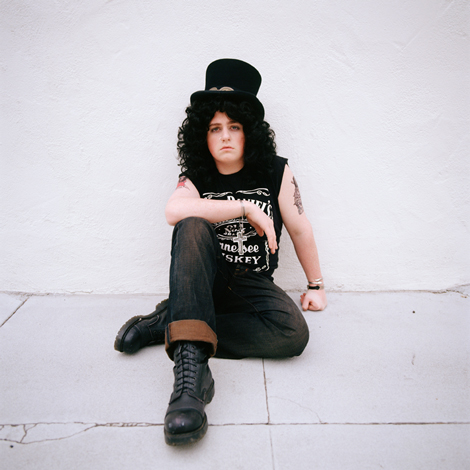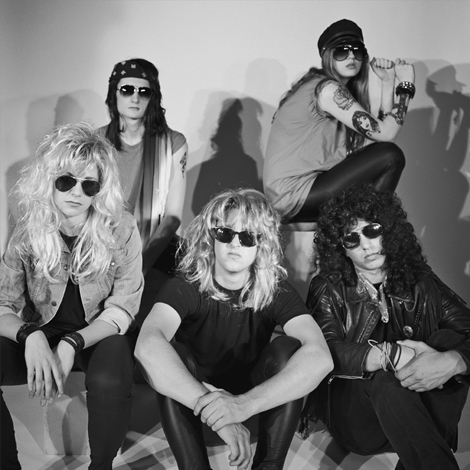Laura London often channels celebrities through her photography, but not necessarily in ways that you’d expect. She doesn’t document musicians, models or actors onstage or off, or portray them in surreal situations like say, Annie Liebovitz does. Instead, she asks teens and young adults she knows to perform for the camera. By photographing them preening and vamping as an exploration of idealized identity, London’s images become about the nature of culturally indoctrinated emulation.
In one of her images from “Rock Star Moment,” a series from 2000, a teen faces the camera with attitude, a guitar hung at her waist. Decked out in baby-doll dress and platinum wig, with black nail polish and smeary lipstick, the girl passes as a juvenile version of Courtney Love. In another picture the girl is dressed in black, leaning over a bathroom sink. Her mirrored reflection reveals a face masked with dark eyeliner and blood-red lipstick, her expression feigning Trent Reznor’s creepy living-dead look. Those two photographs suggest how London approaches her young subjects; that collaboration is a necessary component, even if it is left ambiguous as to whose imagination (the photographer’s or the model’s) is really being tapped.
“Once Upon a Time… ” is London’s most recent and ambitious series, begun in 2007 and periodically updated. Like her earlier work, it involves collaboration with young actors and a reliance on imagination. But the concept for the series was sparked by memories from a real situation. Rose, the charismatic singer of Guns N’ Roses, was a neighbor of London’s in 1990. One only had to stand in line at the supermarket to know about his on-and-off relationship with his then-wife, Erin Everly. Rose was often in the news for volatile behavior, and word in the neighborhood was that he argued with his wife and painted graffiti on their garage door. London took a photo of the garage door and Garage Text, 2010, is the result. (The spray-paint scrawl even referenced “Sweet Child O’ Mine,” a famous GNR song he wrote, inspired by Everly.)
London never intended to publish anything from the roll of film she shot that day, and put it away. About two decades later, it became the catalyst for this new body of work. Most pictures from the series are invented scenes, for which she hired a crew to help: actors, a makeup artist, and an artist to paint the many fake tattoos. Whether a male or female model stands in as “Axl,” he/she becomes the androgynous sex symbol Rose was in his youth: slim and muscular, with long blond hair, pale skin, pouty lips and mournful eyes. Often, the actor is dressed in a sleeveless white T-shirt to show off tattooed arms, and of course the trademark red bandanna across the forehead.
In Once Upon A Time 6 (2010) London’s model actually posed across the street from Everly’s house, in front of the bushes where rumor held that Rose had thrown his wife’s wedding ring. Neighbors told London they saw him later in the same spot with a metal detector. In the photograph, the actor is wearing a long black coat embellished with colorful embroidery, heavy boots, a black hat, and long blond wig, his face obscured from view. The image resembles a fashion shot, but is infused with reference to an anecdotal occurrence. It is neither pure fact nor exclusively fiction.
In Once Upon A Time 1 (2009) London’s nephew projects a calm and in-control performer, charismatic and sexy. He’s a pretty boy with a bad-boy aura, his arms covered in tattoos of girls and crosses, dressed in a Mickey Mouse T-shirt and bandanna as head-scarf. The nephew has the young Axl’s delicate complexion, but not the buff physique, which adds a level of humor. So do the painted-on eyebrows and tattoos and the actor’s melodramatic expression. In other photographs, “Axl” poses with “Erin.” In True Love Tattoo (2010) “Erin” stands alone with her bare back to the viewer. Her long, wavy, honey-brown hair is seductively wrapped around her neck to reveal a tattoo with roses, birds, hearts and the message “true love.” (Rose’s real-life relationships were tumultuous, with legal accusations of assault and battery from not just Everly, but Rose’s subsequent main squeeze, supermodel Stephanie Seymour.)
“Axl” comes with an entourage of not just ex-girlfriends but ex-bandmates. Another of London’s nephews poses as guitarist Slash, in a wig of long black curly hair and a Jack Daniels Whiskey T-shirt. He looks fey, with makeup and jewelry, in spite of the signature top hat, sunglasses, tattoos and heavy boots. In still more pictures, some black and white rather than color, “Axl” and “Slash” are joined by other members of GNR’s original lineup, circa the celebrated 1987 album Appetite for Destruction. The models’ performed demeanors add an air of all-out ridiculousness in the vein of This is Spinal Tap.
In Once Upon A Time 9 (2010) a bare-chested and jean-clad “Axl” looks like a drag queen in a disheveled wig, with heavy painted eyebrows and pink lips. He hugs himself and feigns angst. Another example of gender-bending as a comedic play on androgyny is London’s inspiration to have a female model pose as the protagonist. London’s young intern becomes “Portrait 1” and two images—one of her in cowboy boots on a carpet and the other looking like the real-life young woman she is, seated on a stool—seem a perfect pair to convey the contrast between reality and acting and play it for humor.
The melodrama that London’s models project as deadpan and earnest brings to mind reality TV. Think of The Osbournes. And if you consider that the deliberate blurring of fact and fiction may be our updated version of the long tradition of documentary photography, reality TV is a good parallel. London’s photographs are about the nature of “seeing” in our now over-exposed society. With a 24/7 media environment dominating real life, truth and fiction become fused—an ironic condition for a medium that traditionally kept those realms separate.






